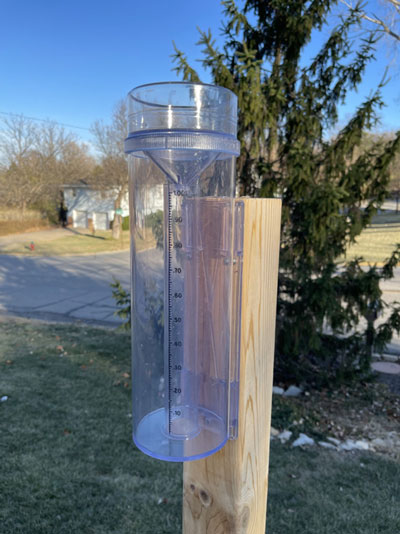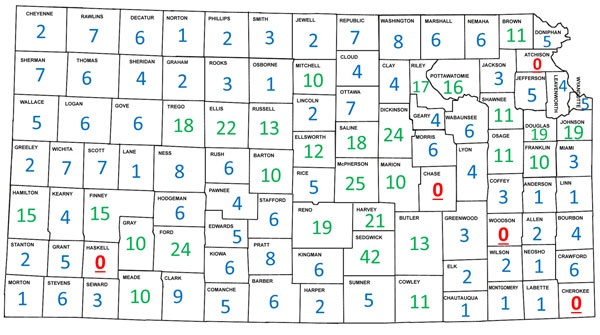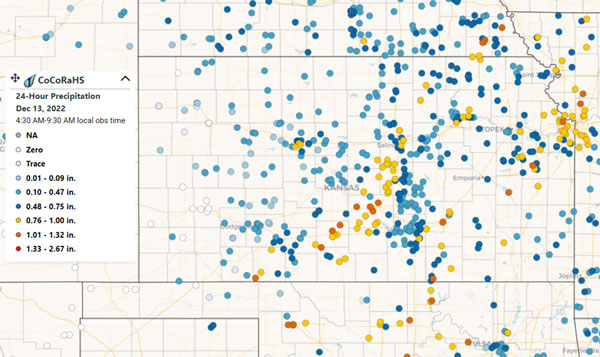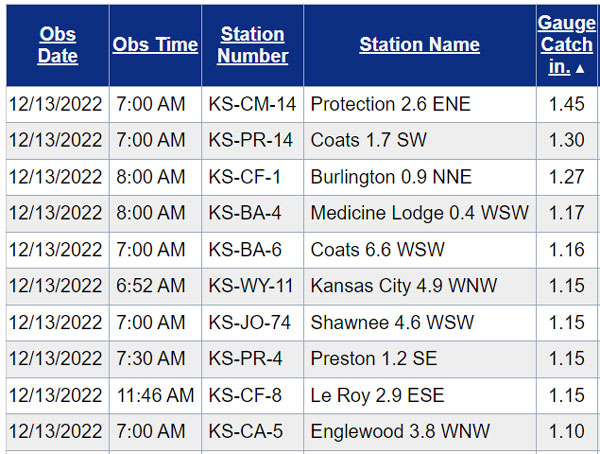March Madness is upon us! While many folks’ thoughts turn towards basketball, brackets, and buzzer-beaters, the weather community has its own March Madness event: a challenge amongst US states to get the highest number of new observers signed up for a program called CoCoRaHS.
CoCoRaHS, the Community Collaborative Rain, Hail, and Snow Network, is a citizen-based project where observers measure precipitation at their home or business using a standard, high-quality rain gauge (Figure 1), and report their daily totals each morning via the project’s web site or through the CoCoRaHS mobile app. CoCoRaHS aims to obtain an accurate picture of where and how much precipitation falls across North America. CoCoRaHS began in 1998 at Colorado State University. Kansas was the third state to join back in 2004. 2023 marks the 25th anniversary of the project.

Figure 1: The official CoCoRaHS rain gauge. Photo by Matthew Sittel, K-State Research and Extension.
CoCoRaHS in Kansas
There are about 760 active observers in Kansas, but we need more. Despite a count that averages out to around 7 observers per county, there are five counties in Kansas with no active observers: Atchison, Chase, Cherokee, Haskell, and Woodson (Figure 2). There are around two dozen more counties with three or fewer observers. Why is statewide coverage so important? The Kansas Climate Office uses precipitation reports (rain, snow, and ice) to assess drought conditions across Kansas. Without reports, we have no idea exactly how much rain fell, or exactly where it fell and where it didn’t, which makes it more difficult to properly determine drought status. It’s important to also report when it does not rain at your location. Documenting the fact that a part of the county missed a precipitation event helps improve our understanding of drought conditions. That information is also useful in improving radar and satellite rainfall estimates.
We occasionally hear from people who comment that the weekly US Drought Monitor map, which our office contributes to weekly, doesn’t accurately reflect conditions at their location. When we ask if they have reported rainfall (lack of rainfall) from their location, they say they haven’t. We are only as good as the data we receive!
In the wetter months, thunderstorms may impact one part of a county or just one city, and not another. Without CoCoRaHS, our knowledge is limited to the few reports we get from airports and cooperative observers. We are missing a lot of territory with so few reports. That’s where CoCoRaHS is invaluable. Your reports are not just for the Kansas Climate Office; other agencies, such as the National Weather Service and county and local agencies, use the information to track flooding risk, municipal water supplies, groundwater availability, lake levels, and river stream flows.

Figure 2: County-by-county totals of active CoCoRaHS observers across Kansas as of March 2023.
Users who visit the CoCoRaHS website can view tables and maps of precipitation amounts (Figures 3 and 4) for any or all locations in the United States. Users can also view totals for varying lengths of time, from days to months. Every CoCoRaHS report received further improves the quality of the products, but there are still spatial and temporal gaps in the data where there are no observers. That’s where you come in-we need your help to increase coverage across the state! The best part of CoCoRaHS, at least for Kansans, is that we provide the standard rain gauge free of charge to new observers who request one. We are the only state in the nation that does this. The reason for this is simple: the observational data we receive from our observers is invaluable to our mission to serve Kansas. It’s a great partnership: we supply the rain gauges, you supply the data, and together we help our fellow Kansans.

Figure 3. Total precipitation map from the CoCoRaHS web page for the 24-hour period ending at 7 AM CST on December 13, 2022.

Figure 4. Tabular display of precipitation data from the CoCoRaHS website.
Join CoCoRaHS
We hope you’ll consider joining CoCoRaHS; visit cocorahs.org to learn more about the project and to become an observer. As of March 21, 35 new observers have been added for Kansas, and our state is in the Elite 8; we are in 8th place on the list of most new observers for any state. We added 37 new observers in March 2022; with your help, we can surpass that mark this year. Help us track the weather across Kansas; join CoCoRaHS today!
Matthew Sittel, Assistant State Climatologist
msittel@ksu.edu